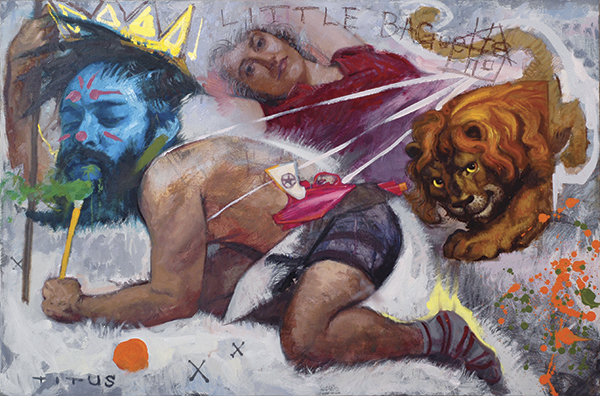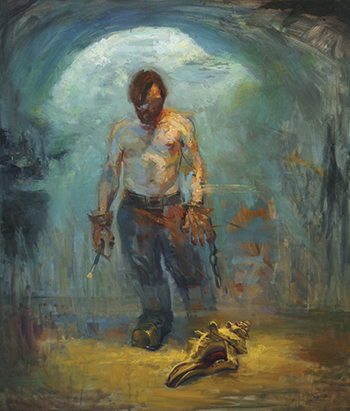A Slice of Titus Castanza

“Triumph of Divine Love” by Titus Castanza
Titus Castanza says his art is about survival.
Realizing that fact pushed him to hone and focus his painting style, an expressive, raw, immediate and honest take on the world through his eyes.
“My art is about my progression through my life. I’m constantly in survival mode. I try to paint quick, expressive pieces that have meaning to me. I’m not trying for the equivalent of writing a novel. They’re more like short stories or a poem,” he says. “It doesn’t matter how good you are, as you become a seasoned, experienced artist, you realize that expressive part is really how you connect. You give people that raw thing that’s within you.”
Castanza, whose work is on the cover of this issue, contributed the “T” to the Rock Martinez-organized TUCSON mural on Speedway Boulevard and Stone Avenue, the first street or public piece of art he’s ever done. Much of his work consists of self-portraits.
“I’m looking at myself and documenting myself. It’s self-expression, trying to figure out why you’re in this world, why you’re here now and why you’re surviving and pulling through as an artist,” he says. “I’m just trying to make something that’s art. I’m not trying to make something that the world of art will accept. That’s the cheapest thing an artist can do, make artwork for other people to accept it. I make artwork for myself, usually with the idea that nobody else will see it.”
Most of his paintings are done in one sitting, a rarity among the artists he knows.

“Death of the Beast” by Titus Castanza
“Earlier on, I would work on them for periods of time, even repainting them again until I got it right. Now, I trust myself more and end up with pieces that are more powerful,” he says. “If I come back the next day, I could have changed enough to the point that I don’t want to finish the piece in the same spirit. The longer you keep working on a piece, the further you get away from that original sense of what it was.”
Originally from New Jersey, the 38-year-old Castanza spent much of his childhood in Tucson, leaving Arizona in his early 20s for art school in Florida. The last thing his mother wanted him to be was an artist and Castanza had plans to study aviation and become a helicopter pilot before abruptly shifting gears.
“I just woke up one day and said ‘I have to be an artist.’ It must’ve worked itself out in my sleep. It chose me and even though I’d resisted it, I was stuck with it. It was just a switch that went off,” he says.
Castanza put together his portfolio and applied to the Ringling College of Art and Design in Sarasota. When the acceptance came, Castanza was completely broke, so he took the 1978 Jeep he’d spent five years restoring, finished the job, sold it at a car show within 30 minutes for half what it was worth, paid his first semester tuition and bought a plane ticket. His life changed completely within a week.
“I told my mother that I don’t need a Plan B. If I put any energy into a Plan B, I won’t be able to conquer Plan A,” he says.
After graduating, Castanza moved to Philadelphia to work as a staff artist at the Franklin mint, working mostly on illustrations of World War I, wildlife and dragons for the company’s collectibles. Frustration with the job set in, so he left and spent most of the next decade as a freelance illustrator. Living in Washington D.C., Castanza went through another period of reflection and decided he had to go all-in as an artist, so he moved back to Tucson, where he found a studio in the Citizens Warehouse downtown.
“I might die a broke, poor artist and it’s taken me years to be in a place where I’m OK with that, because it’s about the art,” he says. “You have to get into your own brain and operate from within on a very sincere, honest level and put your energy and your life into your art.”
To learn more about Titus and to view some of his work, visit TitusCastanza.com.




